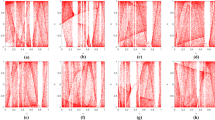Abstract
A new method for digital image scrambling transformation, namely Magic Cube Transformation, was proposed and its principle was introduced. Combined with the Logistic mapping in non-linear dynamics system, an image encrypting and decrypting algorithm based on Magic Cube Transformation was designed. A natural chaotic sequence was created with the key. The image matrix was transformed with this chaotic sequence, using the Magic Cube Transformation. Then an encrypted image was resulted. The decrypting operation was the reverse process of encryption. The experimental results indicate that the proposed algorithm can get satisfying effect. Finally, the characteristics of the algorithm were summarized and the aspects of the subsequent work were prospected.
Preview
Unable to display preview. Download preview PDF.
Similar content being viewed by others
References
Yen, J.C., Guo, J.I.: Efficient hierarchical chaotic image encryption algorithm and its VLSI realization. IEE proceedings-vision image and signal processing 147(2), 167–175 (2000)
Ujvari, T., Koppa, P., Lovasz, M., et al.: A secure data storage system based on phase-encoded thin polarization holograms. Journal of optics A-pure and applied optics 6(4), 401–411 (2004)
Wang, R.Z., Lin, C.F., Lin, J.C.: Image hiding by optimal LSB substitution and genetic algorithm. Pattern recognition 34(3), 671–683 (2001)
Cai, L.Z., He, M.Z., Liu., Q.: Digital image encryption and watermarking by phase-shifting interferometry. Applied optics 43(15), 3078–3084 (2004)
Qi, D.X., Zou, J.C., Han, X.Y.: A new class of scrambling transformation and its application in the image information covering. Chinese in Science(Series E) 43(3), 304–312 (2000)
Finher, Y.: Fractal image compression. Fractals 2(3), 347–361 (1994)
Scharinger, J.: Fast encryption of image data using chaotic Kolmogorov flows. In: Proceedings of the International Society for Optical Engineering, San Joe, California, vol. 3022, pp. 278–289 (1997)
Dedieu, H., Ogorzalek, M.J.: Identifiability and identification of chaotic systems based on adaptive synchronization. IEEE Trnas Circuits & Sys. I 44(10), 948–962 (1997)
Xiang, H.: Digital watermarking systems with chaotic sequences. In: Proceedings of Electronic Imaging 1999. Security and Watermarking of Multimedia Contents, SPIE, San Jose, vol. 3659, pp. 449–457 (1999)
Author information
Authors and Affiliations
Editor information
Editors and Affiliations
Rights and permissions
Copyright information
© 2005 Springer-Verlag Berlin Heidelberg
About this paper
Cite this paper
Zhang, L., Ji, S., Xie, Y., Yuan, Q., Wan, Y., Bao, G. (2005). Principle of Image Encrypting Algorithm Based on Magic Cube Transformation. In: Hao, Y., et al. Computational Intelligence and Security. CIS 2005. Lecture Notes in Computer Science(), vol 3802. Springer, Berlin, Heidelberg. https://doi.org/10.1007/11596981_145
Download citation
DOI: https://doi.org/10.1007/11596981_145
Publisher Name: Springer, Berlin, Heidelberg
Print ISBN: 978-3-540-30819-5
Online ISBN: 978-3-540-31598-8
eBook Packages: Computer ScienceComputer Science (R0)




